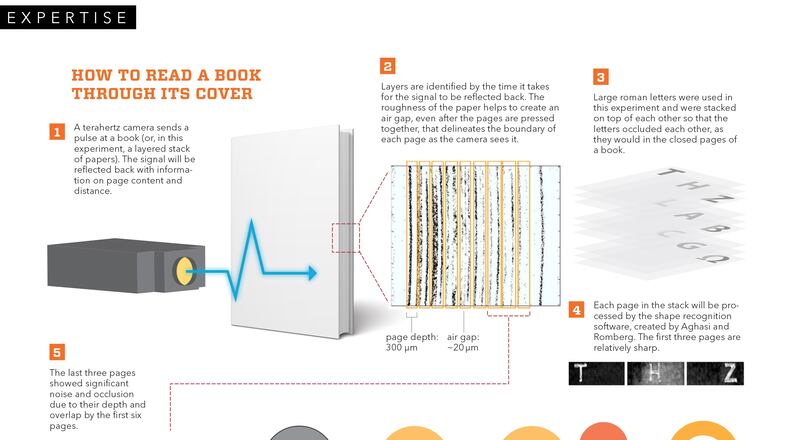Researchers at Georgia Tech are helping design a machine that literally looks through books.
Working with scientists at MIT, they use a terahertz scanner and shape recognition software to read, page by page, the interior of a book while the cover is still closed.
It's a technology that could conceivably be used to read ancient scrolls that are too fragile to unroll, but it can be applied to the non-invasive analysis of all kinds of layered materials.
Justin Romberg, Schlumberger Professor in Georgia Tech's School of Electrical and Computer Engineering, said the experiment grew out of a desire to combine forces with MIT scientists to see how the MIT scanner and Georgia Tech's signal processing software could use the "mathematics of geometric regularization."
“When we did this work, we didn’t think about any of the applications,” said Romberg. “We just thought it would be cool.”
The project began in 2014 as a collaboration between the Media Lab at MIT and Romberg's research group. "There's a guy named Ramesh Raskar, who's builds all kinds of crazy cameras," said Romberg, "and a post-doc named Barmak Heshmet, who does computational imaging."
Heshmet discovered that 10 years ago MIT researchers used terahertz waves to read the interior of a closed envelope.
“That was really inspiring to me,” said Heshmet, during a video interview conducted by MIT. “I was really curious. I wanted to know how deep you could read through a closed book because nobody had tried that.”
MIT’s scanner works by sending out pulses of electromagnetic radiation at a frequency between radio waves and visible light. “These waves have interesting properties,” said Romberg. “They can penetrate through things like paper but bounce off things that contain water, so it goes through paper but bounces off ink.”
Researchers can time the return of these bursts of energy and determine which page they’re bouncing off of, down to the fraction of a millimeter. But the reflected waves, while full of information, are also crowded with noise. “We use models for what we’re imaging to clean up the noise, and coherent processing to take a mess and turn it into information,” said Romberg.
The software was created by Romberg and Alireza Aghasi, formerly a Georgia Tech post-doctoral researcher. It breaks down each letter into basic shapes, and compares the information received to a catalog of shape combinations.
This sort of “machine vision” is comparable to the computations that allow an autonomous car to recognize its surroundings.
Rather than a book, the researchers used a sheaf of pages and found that the teraherz scanner could deliver information as deep as nine pages into the bundle.
The outlines of letters buried nine pages deep were so vanishingly vague, however, that the researchers used additional software to increase contrast.
Raskar and Heshmet have developed cameras for many exotic purposes, including cameras that see around corners and cameras that record “hyperspectral” images in frequencies invisible to the human eye.
Romberg, who grew up outside Washington, D.C., earned his bachelors degree and his PhD at Rice University in Houston. He taught applied mathematics at Caltech in Pasadena, Calif., before coming to Georgia Tech about 10 years ago.
The data for the experiment were recorded last year, but the paper describing their results was published just a few months ago.
Could the device one day read all the way through a 100-page book? Maybe, said Romberg. But seeing directly through nine pages is impressive on its own. “Even that it goes that far is a miracle.”
About the Author
Keep Reading
The Latest
Featured



